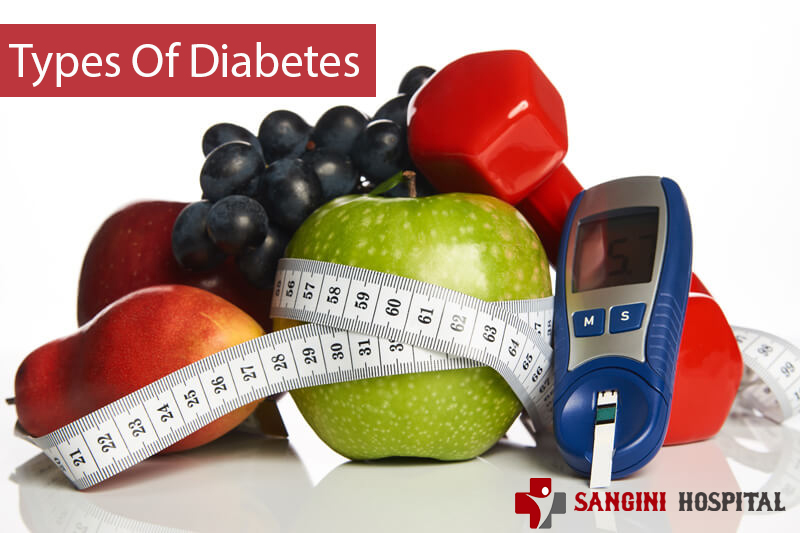
Diabetes Mellitus
Diabetes is a Greek word meaning Passing through and Mellitus meaning honey or sweet. Diabetes is a metabolic disorder characterised by high blood sugar for prolonged period. Overall prevalence of Diabetes in India is 7.3 %.
Definiion of Diabetes :
WHO diabetes diagnostic criteria
| Condition | 2-hour glucose | Fasting glucose | HbA 1c |
|---|---|---|---|
| Unit | mg/dL | mg/dl | DCCT % |
| Normal | <140 | <110 | <6.0 |
| Impaired fasting glucose | <140 | ≥110 & <126 | 6.0–6.4 |
| Impaired glucose tolerance | ≥140 | <126 | 6.0–6.4 |
| Diabetes | ≥200 | ≥126 | ≥6.5 |
Fasting blood glucose is from blood taken after 8 hours of fasting condition.
Post prandial blood sugar is measured 2 hours after administration of 75 grams of glucose.
Glycated Haemoglobin is a random sample, taken any time of day.
Positive blood sample for FBS or PPBS should be repeated by some other day to document diabetes. HbA1c can also add to diagnosis.
TYPES OF DIABETES :
TYPE 1 or Insulin Dependent Diabetes Mellitus or Juvenile Diabetes Mellitus:
Pancreas produces zero or very little insulin, so that Insulin administration is needed for survival. It is either genetic or autoimmune or idiopathic. 10 % of total Diabetics are type 1. Usually it occurs in patients less than 30 years of age, lean body mass and have very low fasting insulin and c peptide level. Chances of complications like diabetic ketoacidosis, retinopathy, neuropathy and gastroparesis are high with it.
Type 2 or adult onset Diabetes (previously called non-insulin dependent diabetes)
Either there is a lesser insulin production or there is insulin resistance. Grossly, it’s a lifestyle disorder due to lack of activity, obesity, junk food, stress, urbanization. Patients are usually above 40 years of age and obese. Chances of associated lifestyle disorders like hypertension, hyperlipidaemia, obesity, fatty liver disease and atherosclerosis are higher with it.
Gestational Diabetes:
2 – 10 % of pregnant ladies develop GDM due to Insulin resistance due to placental hormones or reduced insulin production. Macrosomia (increased birth weight), CNS defects, congenital heart anomalies and skeletal muscle defects are usual complications in kids. In most cases, it recovers after delivery but 5 – 10 % females develop type 2 Diabetes. Dietary changes, oral medicines and insulin can help in controlling blood sugar.
MATURITY ONSET DIABETES OF YOUNG (MODY)
Genetic disorder either due to reduced insulin production or peripheral utilization of glucose. 1 – 2 % of such cases amongst all diabetics, respond very well to oral hypoglycaemic despite young age of onset of Diabetes.
SYMPTOMS OF DIABETES:
Most cases are asymptomatic, as in they can be accidentally diagnosed by high blood sugar on random check or health check-up.
Increased thirst, frequent urination, increased hunger, leg pains, unintentional weight loss or blurred vision are presenting complains. Slow healing of wounds or rashes on skin and private parts are also presenting complains.
INVESTIGATIONS:
Anyone, first time diagnosed with Diabetes should undergo following investigations
1. Self-monitoring of blood glucose: frequently at home.
2. HbA1c should be measured every 3 monthly
3. lipid profile
4. Creatinine
5. Urine r m and urine for micro albumin
6. ECG
7. Tred mill test
8. Eye (fundus) examination
9. Foot examination.
PREVENTION :
Type 1:
There is no effective mean of prevention as of now.
Type 2:
90 minutes of daily exercise, low saturated fats in diet, avoiding obesity and smoking cessation are effective means of prevention globally. Poly unsaturated fats and fibres help.
MANAGEMENT :
A. LIFESTYLE CHANGES
- Lose weight gradually to attain normal body mass index of 18.5 to 24.9. Weight loss shouldn’t be more than 5 to 8 % per year.
- One hour and fifteen minutes of intense exercise or 2 hours and 30 minutes of moderately intense exercise per week.
- Replacing refined carbohydrates with whole grains and increase intake of vegetables and other foods high in dietary fibre.
- Reduce junk food and saturated fats.
- Carbohydrates eventually convert into sugar, so watch out your carb intake.
- Achieving a higher amount of fibre in the diet by including wholegrain foods in the diet and consuming more: Vegetables, Fruits, Beans and Lentils.
- Avoid stress and increase capacity to bear one.
- Do yoga.
- Limit takeaway and processed food.
- Eat less fatty food.
- Frequent small meals.
- Stop tobacco use.
- Reduce alcohol intake to 15 ml per day.
B. MEDICINES
Achieving normal or near normal blood sugar can delay progression of damage to eyes and kidney. Atherosclerosis can also be delayed or prevented with good sugar control. Treatment should target Fasting blood sugar 110, post prandial blood sugar 140 and HbA1c less than 7. Treatment should have minimal episodes of low blood sugar. Treatment should also eye on controlling other associated disorders like Hypertension, Ischaemic heart disease, obesity and hyperlipidaemia.
Type 1 Diabetes
Needs insulin only. Oral medications are not effective.
Type 2 Diabetes
Initially managed with oral agents, which lower glucose absorption, reduce hepatic glucose production, increase insulin sensitivity, increase sugar excretion through kidney and increase insulin production. Later on, people may need insulin for adequate control.
Gestational Diabetes :
Metformin is safe in pregnancy. Insulin remains mainstay of treatment in those uncontrolled.

